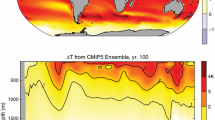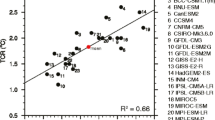Abstract
A change in CO2 concentration induces a direct radiative forcing that modifies the planetary thermodynamic state, and hence the surface temperature. The infrared cooling, by assuming a constant temperature lapse-rate during the process, will be related to the surface temperature through the Stefan–Boltzmann law in a ratio proportional to the new infrared opacity. Other indirect effects, such as the water vapor and ice-albedo feedbacks, may amplify the system response. In the present paper, we address the question of how a global climate model with a mixed layer ocean responds to different rates of change of a well-mixed greenhouse gas such as CO2. We provide evidence that different rates of CO2 variation may lead to similar transient climates characterized by the same global mean surface temperature but different values of CO2 concentration. Moreover, it is shown that, far from the bifurcation points, the model’s climate depends on the history of the radiative forcing displaying a hysteresis cycle that is neither static nor dynamical, but is related to the memory response of the model. Results are supported by the solutions of a zero-dimensional energy balance model.



Similar content being viewed by others
References
Benzi R, Sutera A, Vulpiani A (1981) The mechanism of stochastic resonance. J Phys A: Math Gen 14:L453–L457
Berk A, Bernstein LS, Robertson DC (1989) MODTRAN: a moderate resolution model for LOWTRAN 7, Report GL-TR-89-0122. Air Force Geophys. Lab, Bedford, MA
Bordi I, Dell'Aquila A, Speranza A, Sutera A (2004) On the midlatitude tropopause height and the orographic-baroclinic adjustment theory. Tellus 56A:278–286
Bordi I, Fraedrich K, Lunkeit F, Sutera A (2007) Tropospheric double-jets, meridional cells and eddies: a case study and idealized simulations. Mon Wea Rev 135:3118–3133
Budyko MI (1969) The effect of solar radiation variations on the climate of the Earth. Tellus 21:611–619
Fraedrich K, Lunkeit F (2008) Diagnosing the entropy budget of a climate model. Tellus 60A:921–931
Fraedrich K, Jansen H, Kirk E, Luksch U, Lunkeit F (2005) The planet simulator: towards a user friendly model. Meteorol Zeitschrift 14:299–304
Freidlin MI, Mayergozy ID (2001) Hysteresis in randomly perturbed fast dynamical systems. Physica B 306:15–20
Goldsztein GH, Broner F, Strogatz SH (1997) Dynamical hysteresis without static hysteresis: scaling laws and asymptotic expansions. SIAM J Appl Math 57:1163–1187
Held IM, Winton M, Takahashi K, Delworth T, Zeng F, Vallis GK (2010) Probing the fast and slow components of global warming by returning abruptly to preindustrial forcing. J Climate 23:2418–2427
Intergovernmental Panel on Climate Change (1990) In: Houghton JT, Jenkins GJ, Ephraums JJ (eds) Climate change: the IPCC scientific assessment. Cambridge University Press, Cambridge, UK
Lucarini V, Fraedrich K, Lunkeit F (2010) Thermodynamic analysis of snowball earth hysteresis experiment: efficiency, entropy production, and irreversibility. Q J R Met Soc 136:2–11
Manabe S, Stouffer RJ, Spelman MJ, Bryan K (1991) Transient response of a coupled ocean–atmosphere model to gradual changes of atmospheric CO2. Part I: annual-mean response. J Climate 4:785–818
Myhre G, Highwood EJ, Shine KP (1998) New estimates of radiative forcing due to well mixed greenhouse gases. Geophys Res Lett 25:2715–2718
Rahmstorf S (1995) Bifurcation of the Atlantic thermohaline circulation in response to changes in the hydrological cycle. Nature 378:145–149
Zhu X, Fraedrich K, Blender R (2006) Variability regimes of simulated Atlantic MOC. Geophys Res Lett 33:L21603
Zhu X, Fraedrich K, Liu Z, Blender R (2010) A demonstration of long term memory and climate predictability. J Climate 23:5021–5029
Acknowledgments
Support by the Max Planck Society is acknowledged (KF). We thank the two anonymous reviewers for their constructive comments that helped improving the presentation of the paper.
Author information
Authors and Affiliations
Corresponding author
Rights and permissions
About this article
Cite this article
Bordi, I., Fraedrich, K., Sutera, A. et al. Transient response to well-mixed greenhouse gas changes. Theor Appl Climatol 109, 245–252 (2012). https://doi.org/10.1007/s00704-011-0580-z
Received:
Accepted:
Published:
Issue Date:
DOI: https://doi.org/10.1007/s00704-011-0580-z




